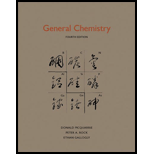
Interpretation:
The reason why the energy evolved in the process decrease in the order has to be given.
Concept Introduction:
Coulomb’s Law of attraction:
Coulomb’s law states that the energy of interaction of two ions is directly proportional to the product their electric charges and is inversely proportional to the distance between them. The formula is,
The value of proportionality constant depends on the units of charges and distance.
Explanation of Solution
The given reaction is,
Sodium chloride:
This equation can be simplified into two reactions of first
Sodium forms monopositive ion
Chlorine forms mononegative ion
The distance d is sum of the distance between chlorine and sodium. The distance d is calculated as,
The value of energy is calculated as,
The energy of reaction is calculated as,
Sodium bromide:
This equation can be simplified into two reactions of first electron affinity of sodium and first ionization of bromine.
Sodium forms monopositive ion
Bromine forms mononegative ion
The distance d is sum of the distance between bromine and sodium. The distance d is calculated as,
The value of energy is calculated as,
The energy of reaction is calculated as,
Sodium iodide:
This equation can be simplified into two reactions of first electron affinity of sodium and first ionization of iodine.
Sodium forms monopositive ion
Iodine forms mononegative ion
The distance d is sum of the distance between iodine and sodium. The distance d is calculated as,
The value of energy is calculated as,
The energy of reaction is calculated as,
It can be seen that
Want to see more full solutions like this?
Chapter 6 Solutions
General Chemistry
 ChemistryChemistryISBN:9781305957404Author:Steven S. Zumdahl, Susan A. Zumdahl, Donald J. DeCostePublisher:Cengage Learning
ChemistryChemistryISBN:9781305957404Author:Steven S. Zumdahl, Susan A. Zumdahl, Donald J. DeCostePublisher:Cengage Learning ChemistryChemistryISBN:9781259911156Author:Raymond Chang Dr., Jason Overby ProfessorPublisher:McGraw-Hill Education
ChemistryChemistryISBN:9781259911156Author:Raymond Chang Dr., Jason Overby ProfessorPublisher:McGraw-Hill Education Principles of Instrumental AnalysisChemistryISBN:9781305577213Author:Douglas A. Skoog, F. James Holler, Stanley R. CrouchPublisher:Cengage Learning
Principles of Instrumental AnalysisChemistryISBN:9781305577213Author:Douglas A. Skoog, F. James Holler, Stanley R. CrouchPublisher:Cengage Learning Organic ChemistryChemistryISBN:9780078021558Author:Janice Gorzynski Smith Dr.Publisher:McGraw-Hill Education
Organic ChemistryChemistryISBN:9780078021558Author:Janice Gorzynski Smith Dr.Publisher:McGraw-Hill Education Chemistry: Principles and ReactionsChemistryISBN:9781305079373Author:William L. Masterton, Cecile N. HurleyPublisher:Cengage Learning
Chemistry: Principles and ReactionsChemistryISBN:9781305079373Author:William L. Masterton, Cecile N. HurleyPublisher:Cengage Learning Elementary Principles of Chemical Processes, Bind...ChemistryISBN:9781118431221Author:Richard M. Felder, Ronald W. Rousseau, Lisa G. BullardPublisher:WILEY
Elementary Principles of Chemical Processes, Bind...ChemistryISBN:9781118431221Author:Richard M. Felder, Ronald W. Rousseau, Lisa G. BullardPublisher:WILEY





